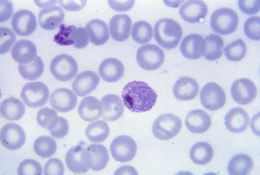This thin film Giemsa stained micrograph reveals a mature Plasmodium vivax trophozoite. P. vivax trophozoites show amoeboid cytoplasm, large chromatin dots, and fine, yellowish-brown pigment. RBCs are enlarged 1 1/2 - 2X, and may be distorted. If visible, Schüffner's dots may appear finer than those seen in P. vivax. Credit: CDC/ Steven Glenn
Strenuous efforts to prevent and treat malaria in recent decades have brought great benefits, particularly against disease caused by Plasmodium falciparum in countries in Africa and the Americas. But malaria caused by its "stealthier and more resilient cousin", P. vivax, now needs to be confronted with high priority, say Lorenz von Seidlein and Nicholas White of the Mahidol Oxford Tropical Medicine Research Unit in Bangkok, Thailand in a Perspective. The piece introduces a Collection on the prevention and treatment of P. vivax malaria in the open access journal PLOS Medicine, published ahead of World Malaria Day on April 25th.
In a Review article in the Collection, Sarah Auburn of the Menzies School of Health Research and Charles Darwin University, Darwin, Australia and colleagues discuss the epidemiology of P. vivax. The parasite is endemic in an estimated 49 countries, and the authors highlight that the main burden of resulting disease falls on young children in remote areas poorly served by health services.
Unlike P. falciparum, P. vivax has a dormant liver stage which makes the parasite more difficult to study and treat, leading to relapsing infections. As discussed by Cindy Chu of the Shoklo Malaria Research Unit, Thailand and White in a second Review article in the Collection, effective drugs are available but the 8-aminoquinolines cause hemolysis in people with glucose-6-phosphate dehydrogenase (G6PD) deficiency. This has limited the use of this class of drugs because infrastructure to support and provide G6PD testing is required prior to providing treatment.
In a further Review article, Kamala Thriemer and coauthors draw together the themes of the Collection and discuss the practicalities of the "radical cure" for P. vivax infection, aiming to eliminate all forms of the parasite in an individual and prevent malaria relapses. "The radical cure is not an optional add-on but has to be an integral part of P. vivax malaria treatment", say the authors. The Collection will also feature a range of research studies on key aspects of the prevention and treatment of P. vivax malaria and these will be published in the coming weeks.
More information: Lorenz von Seidlein et al, Taking on Plasmodium vivax malaria: A timely and important challenge, PLOS Medicine (2021). DOI: 10.1371/journal.pmed.1003593
Sarah Auburn et al. The changing epidemiology of Plasmodium vivax: Insights from conventional and novel surveillance tools, PLOS Medicine (2021). DOI: 10.1371/journal.pmed.1003560
Cindy S. Chu et al. The prevention and treatment of Plasmodium vivax malaria, PLOS Medicine (2021). DOI: 10.1371/journal.pmed.1003561
Kamala Thriemer et al. Towards the elimination of Plasmodium vivax malaria: Implementing the radical cure, PLOS Medicine (2021). DOI: 10.1371/journal.pmed.1003494
Journal information: PLoS Medicine
Provided by Public Library of Science
























